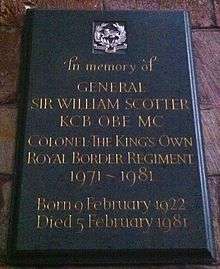William Scotter
| Sir William Scotter | |
|---|---|
|
Headstone of Sir William Scotter in Aldershot Military Cemetery | |
| Born |
9 February 1922 Birkenhead, Wirral |
| Died | 5 February 1981 |
| Buried at | Aldershot Military Cemetery |
| Allegiance |
|
| Service/branch |
|
| Rank | General |
| Commands held |
1st Battalion the King's Own Royal Border Regiment 19th Infantry Brigade British Army of the Rhine |
| Awards |
Knight Commander of the Order of the Bath Officer of the Order of the British Empire Military Cross |
General Sir William Norman Roy Scotter, KCB, OBE, MC (9 February 1922 – 5 February 1981) was Commander-in-Chief, British Army of the Rhine, from September 1978 until October 1980.
Early years
William (Bill) Scotter was born in Birkenhead, Wirral on 9 February 1922, the son of Claude Norman Scotter (born Ulverston, Cumbria in 1889, died 1978 in Hampshire) and Hilda Marie Scotter (née Turner)(1892–1948). He had two brothers and one sister. William was the grandson of Canon William Henry Scotter, one time Vicar at Ulverston and his wife Emma Gordon Dill. William was also the great nephew of Sir Charles Scotter, Baron Walford, Chairman and Managing Director of the London and South Western Railway.
He was educated at St. Bees School, Cumberland. In June 1941 he enlisted in the British Army and served in ranks of the Scots Guards.[1] By 1942 he had attained the rank of Lance Corporal. After attending the Indian Military Academy, Dehra Dun, India, he was emergency commissioned into 7th Gurkha Rifles, Indian Army on 26 November 1942.[1] He served with the 7th Gurkha Rifles in India from 1943 until 1944, first as temporary Captain, then as lieutenant. Then later in Burma from 1944 until 1945.[1] It was for his actions in Burma on the night of the 28 February 1945 at Meiktila as a company commander, where he was wounded, that he was awarded the MC serving as a temporary Major with 1st battalion, 7th Gurkha Rifles.[2]
England
Having returned to England, he was transferred from the Indian Army to the 2nd Battalion Border Regiment in 1945, as a Regular officer.[1][3] After service in Malaya with the 1st Battalion, 2nd Gurkha Rifles, from 1948 to 1951 and graduating from Staff College, Camberley, Surrey, he was Commanding Officer of the 1st Battalion the King's Own Royal Border Regiment[1] and by July 1967 he was promoted to Brigadier and had been appointed commander of 19th Infantry Brigade.[1] In 1965 was awarded the OBE, and in 1970 he was promoted to Major General and appointed Chief of Staff Headquarters Southern Command.[1] In 1972 he became Chief of Staff at Headquarters UK Land Forces.[1] By this time he was also Colonel of the King's Own Royal Border Regiment. Later in 1972 he became Director of Military Operations at the Ministry of Defence.[1]
By 1975 William Scotter was appointed as Knight Commander of the Order of the Bath (KCB),[4] and promoted to Vice Chief of the General Staff at the Ministry of Defence in Whitehall in the rank of Lieutenant General.[1]
In 1976 he became Colonel Commandant of the Army Physical Training Corps Aldershot. From September 1978 was promoted to General, as Commander-in-Chief, British Army of the Rhine, a role he held until October 1980[1] when he was replaced by General Sir Michael Gow, KCB, ADC.
Death

He was appointed to become Deputy Supreme Allied Commander Europe (DSACEUR) in April 1981 . But he died in February 1981 before he had the opportunity to take up this appointment. He was buried at Aldershot Military Cemetery with full military honours.
Memorials
- A plaque to his memory is displayed in the Kings Own Border Regiment Chapel in Carlisle Cathedral
- His uniform and medals are displayed in Cumbria's Museum of Military Life in Carlisle Castle.
References
External links
| Military offices | ||
|---|---|---|
| Preceded by Sir David Fraser |
Vice Chief of the Imperial General Staff 1975–1978 |
Succeeded by Sir John Stanier |
| Preceded by Sir Frank King |
Commander-in-Chief of the British Army of the Rhine 1978–1980 |
Succeeded by Sir Michael Gow |